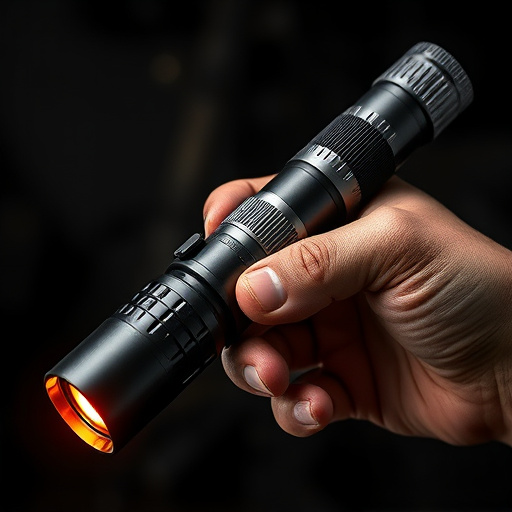Self-defense expandable batons offer personal safety, with compact design and powerful strikes. Effective training involves scenario simulations, focusing on quick decision-making and muscle memory. Training includes agility, offensive/defensive maneuvers, and role-playing for real-world application. Identifying common pitfalls improves skills, emphasizing proper grip, hand positioning, and surrounding awareness.
“Unleash your inner defender with our comprehensive guide to collapsible baton scenario training. In today’s uncertain world, mastering self-defense tools like the expandable baton is crucial for personal safety. This guide explores ‘Understanding Self-Defense Expandable Batons’ as versatile instruments for protection. We delve into ‘The Collapsible Baton Training Scenario,’ offering strategies to prepare for real-life confrontations. From creating effective training drills and role-playing diverse attack situations, to advanced tips and common mistakes to avoid, this guide equips you with the skills needed to confidently defend yourself.”
- Understanding Self-Defense Expandable Batons: Tools for Personal Safety
- The Collapsible Baton Training Scenario: Preparing for Real-World Confrontations
- Creating Effective Training Drills: Techniques and Practice Routines
- Role-Playing Scenarios: Simulating Different Attack Situations
- Beyond the Basics: Advanced Training Tips and Common Mistakes to Avoid
Understanding Self-Defense Expandable Batons: Tools for Personal Safety
Self-defense Expandable Batons: Powerful Tools for Personal Safety
In today’s world, personal safety is a top priority for many individuals. Self-defense expandable batons have emerged as valuable tools to empower people and enhance their ability to protect themselves in various situations. These versatile devices offer a practical solution for those seeking an extra layer of security while walking alone, commuting, or facing potential threats.
The self-defense expandable baton is a compact yet potent weapon designed to provide a strong defense when unfolded. Its unique design allows it to be easily concealed until needed, making it an ideal tool for individuals who want to feel prepared without drawing unnecessary attention. With the ability to extend and lock into place, these batons can deliver powerful strikes, giving users the confidence to deter potential assailants.
The Collapsible Baton Training Scenario: Preparing for Real-World Confrontations
In self-defense training, preparing for real-world confrontations is paramount. The collapsible baton, a versatile tool for personal safety, demands specific scenario training to ensure effectiveness and confidence. A typical Collapsible Baton Training Scenario involves simulating various attacks and teaching students how to respond swiftly and accurately with their batons. This hands-on approach allows trainees to experience the dynamics of close-quarters combat, where quick decision-making is crucial.
By practicing scenarios like defending against multiple assailants or disarming an attacker, individuals become more adept at deploying their expandable batons effectively. The training focuses on developing muscle memory for extending and retracting the baton smoothly while maintaining balance under stress. This preparation translates directly to real-life situations, empowering individuals to defend themselves with confidence in unpredictable environments.
Creating Effective Training Drills: Techniques and Practice Routines
Creating effective training drills for self-defense with an expandable baton requires a thoughtful approach that combines practical application with continuous improvement. Start by designing scenarios that mimic real-life situations, such as walking alone at night or facing an attacker in a confined space. Incorporate movements like pivoting, dodging, and lateral shifts to enhance agility and adaptability. Practice drills should include both offensive and defensive maneuvers, teaching individuals how to extend the baton for distance control and use it as a striking tool while also learning to collapse it swiftly for easier manipulation and self-defense in tight quarters.
Regularly rotate training exercises to keep practitioners engaged and challenged. Introduce variations like time constraints, partner work, or role-playing different attacker behaviors. Encourage active participation by allowing students to suggest scenarios and adapt drills accordingly. Incorporate regular reviews of basic baton handling techniques to ensure proficiency and comfort with the weapon. This holistic approach not only improves physical skills but also boosts mental readiness, making individuals more confident and capable in self-defense situations involving an expandable baton.
Role-Playing Scenarios: Simulating Different Attack Situations
Role-playing scenarios are an integral part of training with a self-defense expandable baton. These simulations allow practitioners to experience various attack situations, enhancing their ability to react instinctively and effectively. By envisioning potential threats, such as unexpected physical assaults or even attempts to grab the baton, trainees can develop quicker decision-making skills.
Through role-playing, students learn to anticipate enemy moves, practice proper baton control, and understand the importance of positioning during a defense. This interactive approach not only improves their technical skills but also boosts confidence in real-world scenarios. By repeatedly facing simulated attacks, individuals become more prepared to handle unexpected situations, making them more capable self-defense practitioners with an expandable baton.
Beyond the Basics: Advanced Training Tips and Common Mistakes to Avoid
Taking your self-defense expandable baton skills beyond the basics involves recognizing and avoiding common mistakes. One frequent error is failing to maintain proper grip and hand positioning, which can compromise control during an encounter. Regularly practice different grips, focusing on a strong yet relaxed hold, especially when using the baton’s full extension. Another mistake is not practicing with both hands, leading to asymmetry in your defense. Ensure you’re comfortable using either hand equally effectively.
Advanced training also includes simulating real-life scenarios and learning to adapt your technique based on distance, angle, and the opponent’s actions. Practice targeting vulnerable areas like the groin, eyes, and throat, but be mindful of legal implications and always prioritize safety. Avoid becoming predictable in your movements; mix up strikes and blocks to keep an attacker off balance. Remember, effective self-defense isn’t just about the baton; it’s about understanding and leveraging your surroundings for added protection.
The collapsible baton, as a powerful tool for personal safety, demands effective training to maximize its potential in real-world confrontations. By understanding the mechanics of these batons and engaging in diverse training scenarios, from basic drills to advanced role-playing, individuals can transform self-defense into a practical, confident skill set. Incorporating this specialized training into your routine equips you with the means to protect yourself effectively, ensuring peace of mind in unfamiliar or threatening situations.
